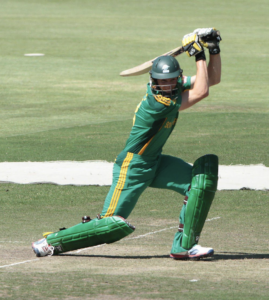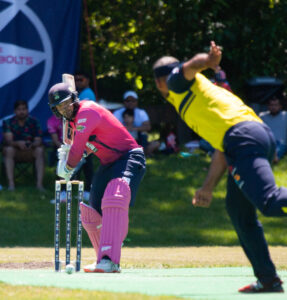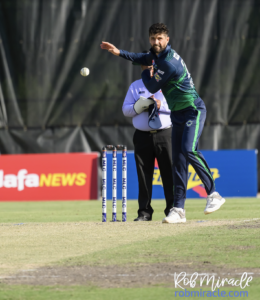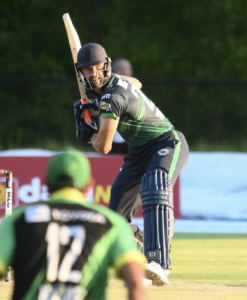The Road to Minor League Cricket is a wildly varied one. Very few players have taken the same route to playing in the top professional league in the US. Steve Steinberg of CricAmerica sat down with two cricketers whose road to this country began in South Africa. Both Andries Gous and Obus Pienaar hail from the land of the Proteas, but that doesn’t mean their adventures were the same.
Andries Gous – Seattle Thunderbolts
“I started playing cricket when I went to school — probably when I was six. That was probably the first time playing in a structured setting. But ever since I can remember, I played as many sports as I could. I played rugby — which is not a sport that’s famous in the USA yet. I played hockey. I did athletics. I played cricket. I think it’s actually very important for kids to do as many things as they can and explore different sports. If it doesn’t teach you a new skill, it will at least you teach you something about life, so you can always take something out of a different sport.”
But it was cricket that had a special hold on him. “Even though I played that many sports, cricket has always been the one sport for me that I love the most. Ever since I can remember, I just love a ball — any ball — and I like to hit things. It doesn’t matter whether I was playing rugby or hockey or whatever, cricket always was like the one sport that I’m missing, basically if I can say it like that.”

“I went through the ranks. I played for my province Under-13, Under-15, Under-17, and then Under-19. And that’s the big one in South Africa. School sport is a massive thing in South Africa. So if you make your province Under-19 and represent your province at the national level, that’s probably when you realize you’re better than most. And then if you make a national side out of that, then probably you’ve got a slim chance of making it as a career. You always have a dream as a child that you want to play for your country in any sport. But for me, it was always that I wanted to represent South Africa in cricket.”
Soon, though, pragmatism and necessity forced the wicket-keeper to re-examine his options. “I remember when Rusty (Theron) phoned me. Obviously, he got me to come to the US, but when he phoned, I was like, geez, I didn’t even know the USA had cricket. Everything was quite new, but for me, I realized that it was always going to be extremely difficult to make the South African side with Quinton de Kock just being a year older than me. And he still has quite a long time playing for South Africa. But besides that, for me, the biggest decision was that I want to give my little boy the best opportunities that I can give him. And America was just the best option for that and for our lives going forward.”
So, how’d he end up with the Seattle Thunderbolts in a place most famous for rain, coffee, Microsoft, and Kurt Cobain? “There were a couple of locations that that were mentioned. But there’s another South African in Seattle that played for nine years with me in the Free State (Shadley Van Schalkwyk). We just thought that Seattle is quite a good fit where we won’t be alone. He’s got someone that he can lean on and I’ve got someone that I can lean on.”
 And it definitely was a good fit. For the second year in a row, Andries has been a force for the Thunderbolts. He’s among the league leaders in runs, average, and strike rate and is a key reason why Seattle has remained in the playoff picture all season. Coming from a country with a strong cricketing culture, how has he found the level of talent in the US? “It’s amazing how the quality of cricketers is in the US at the moment. When we coach the kids, they are unbelievably good. They are probably on the same level as kids (in South Africa). I think once they start playing more on turf wickets, that will really test them and then we’ll know if they’re really that good or not. But the way they’re playing and practicing at the moment, they are extremely talented and extremely good. Last year was a massive success for the minor league. Now, everybody’s a year older, so it’s probably going to get bigger. I’m really excited for the next few years and the major league launching next year.”
And it definitely was a good fit. For the second year in a row, Andries has been a force for the Thunderbolts. He’s among the league leaders in runs, average, and strike rate and is a key reason why Seattle has remained in the playoff picture all season. Coming from a country with a strong cricketing culture, how has he found the level of talent in the US? “It’s amazing how the quality of cricketers is in the US at the moment. When we coach the kids, they are unbelievably good. They are probably on the same level as kids (in South Africa). I think once they start playing more on turf wickets, that will really test them and then we’ll know if they’re really that good or not. But the way they’re playing and practicing at the moment, they are extremely talented and extremely good. Last year was a massive success for the minor league. Now, everybody’s a year older, so it’s probably going to get bigger. I’m really excited for the next few years and the major league launching next year.”
Andries also sees a big advantage that US cricketers have over their international counterparts. “One thing that people never think about is that the USA is such a big country. Wherever you go, there’s going to be different conditions. You can really practice wherever you want in the US to simulate another country’s conditions. So, if you come to Seattle where it rains a little bit more, the wicket will be a little bit softer, so it’ll play completely different than it’ll play in New York or in Los Angeles. That is really incredible.”
Who would Andries like to play with on his Dream XI? “Rashid Khan. He’s just so good. To be a leg-spinner and to be that good at the pace that he bowls is really incredible. And I would say Babar Azam because he’s extremely good in all formats. And I will always pick AB de Villiers. He’s one of the best cricketers to ever play the game.”
Obus Pienaar – Morrisville Raptors
“You just grow up playing cricket and rugby and tennis and athletics. Those are probably the four main sports in South Africa, so you just grew up playing those. Then I went through the state teams, because that would be the big thing in South Africa. You would represent your state. So I did that throughout the age groups. And then once I started making the Under-19 squads, which I did when I was about 16 years-old, then I probably realized, okay, this could potentially be a career. So at the age of 16 or 17, you start thinking about it, although you always thought about it. You know, growing up, you want to be a professional sports person. But I think cricket sort of became a little bit more clear at the age of 16 or 17.”
 Unfortunately, while Obus was preparing for a pro career, his body had other ideas. “I think a lot of young fast bowlers go through the stress fracture in the back. I got mine pretty early on. I was about 21 years-old when I started struggling with my back. And then I was out for three months — a 12-week period where I couldn’t do anything. And, of course, when you want to come back from something like that, you’re going change your action. And I think that eventually cost me because I could never then quite find that same fast bowling action. I just wasn’t the same bowler after I got the stress fracture. And then about age of 25 or 26, I started experimenting with bowling spin. ”
Unfortunately, while Obus was preparing for a pro career, his body had other ideas. “I think a lot of young fast bowlers go through the stress fracture in the back. I got mine pretty early on. I was about 21 years-old when I started struggling with my back. And then I was out for three months — a 12-week period where I couldn’t do anything. And, of course, when you want to come back from something like that, you’re going change your action. And I think that eventually cost me because I could never then quite find that same fast bowling action. I just wasn’t the same bowler after I got the stress fracture. And then about age of 25 or 26, I started experimenting with bowling spin. ”
And how smooth was the transition from pace bowling to spin bowling? “Not very natural. No. It took me a long time. I think for a lot of people, it would’ve come a bit more naturally, but for me, I struggled. I worked really, really hard at it for about two or three years. And I would say the last two or three years, it’s been decent — to the point where you can really make a contribution. I’m lefthanded and I’m tall, so there’s definitely an advantage there. And I think I use my brain more than my skill, just trying to understand what the batter is trying to do and what he’s thinking. Then I try and be one step ahead of the batsman. The biggest thing is that I’m enjoying bowling spin.”
So what lured the now-spin-bowling all-rounder away from South Africa? “To be really honest, I think it was more of a lifestyle thing in terms of just looking at life after cricket. There wasn’t a lot of opportunities in South Africa, just in terms of jobs and in terms of security. So, we were looking — my wife and I — to sort of get out of South Africa. And then luckily with Rusty Theron being here, this opportunity came up. So, it actually worked out really well. It was good timing.”
Obus spent his initial minor league season with the St. Louis Americans and punished opposing bowlers. His 444 runs were among the highest in the conference. And maybe the most important half-dozen of those runs being his game-winning, last-ball six against the Houston Hurricanes. “That was really good. I just got lucky, because he bowled a good over and didn’t miss his yorkers and he just sort of missed it. It was a good feeling and nice to win that game. But, yeah, he just missed it. So, lucky for me.”

This season, Obus has taken his talents to North Carolina to play for the Morrisville Raptors and is once again putting up lofty numbers. His strike rate is currently north of 170 and he recently broke the Minor League Cricket record for the fastest century — picking up his hundred in just 37 balls. And he’s excited about calling Church Street Park his new home. “It’s awesome. That’s one of the main reasons I wanted to come here — they needed some coaches as well. I just wanted to get in a little bit better spot for my cricket personally. And obviously I think this is going to be a hub in the future. They’re building up the stadium. They’ve got the cricket facility already, so that’s why I wanted to come this way.”
His success here may have Obus rethinking when he wants to start his “life after cricket.” “I’ve always wanted to play at the World Cup and play international cricket. I’ve not been able to do that up until this point. So, we’ll see how it goes. It’s definitely something I’m thinking of. It’s not the be-all and end-all, but I still want to play cricket for at least another six to ten years. I’m still enjoying it. It’s my number one purpose at the moment to still be playing cricket at a competitive level and if it goes that way, I’ll be excited to play for USA.”
Who would Obus like to play with on his Dream XI? “AB de Villiers. He’s a South African. He also likes golf, so you can play some golf with him off the field. And I suppose someone like a Rashid Khan. A leg-spinner with a good googly. And then I’d probably opt for some raw pace, so a Mitchell Starc or someone like that who can just bowl nice and quick.”

